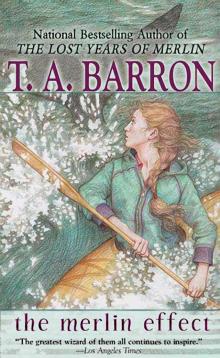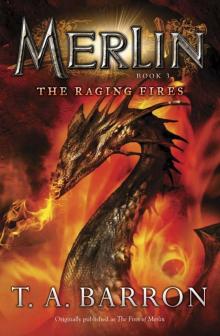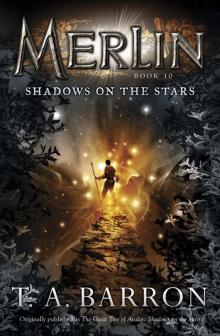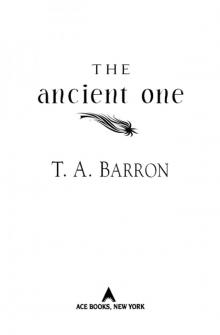- Home
- T.A. Barron
Merlin: The Book of Magic Page 3
Merlin: The Book of Magic Read online
Page 3
Lost Years
Merlin's Lost Years were the crucial formative years of his youth, kept secret for centuries. During those years, Merlin grew from age twelve to seventeen—and changed dramatically, from a half-drowned boy who washed ashore on a strange coast to a masterful young wizard. At the beginning of those years, he was a homeless, nameless lad with no clue about his past or future. By the end, he was well on his way to becoming the mage of Camelot, the mentor of King Arthur, and the greatest wizard of all times.
Although he would ultimately make his home on Earth, the world of Fincayra—where he spent his Lost Years—claimed most of Merlin's youth. And also, perhaps, his heart. For Fincayra rose out of the ocean mist to welcome him; Fincayra helped him discover his magic as well as his deepest passions; and Fincayra gave birth to another magical realm—Avalon, which sprouted from a seed planted by Merlin himself. During his years on Fincayra, Merlin learned his greatest lessons: the wonders of Nature, the Seven Songs of Wizardry, the importance of seeing beneath the surface of things, and the remarkable power of love. And during those years, he gained many of his life's dearest friends—including Rhia, Trouble, Cairpré, Hallia, Eremon, Elen, and Shim. Small wonder, then, that when Merlin finally saved Fincayra, he shuddered at the thought of ever leaving it. For the world of his Lost Years had become his first true home.
Merlin (Olo Eopia)
Long ago, on a remote and rugged coast, a half-drowned boy washed ashore. The sea had robbed him of everything he'd once known. He had no memory, no idea at all who he was. He didn't even know his own name. When he first opened his eyes to the sight of the sea, the rocky shore, and the screeching gulls overhead, no one could have possibly convinced him that he would survive that day to become a wizard. Yet he would, in fact, become Merlin: the person celebrated in three worlds—Fincayra, Avalon, and Earth—as the greatest wizard of all times.
During the Lost Years of his youth, Merlin gained much—and also lost much. Along with his dear friends Rhia, the hawk Trouble, and the giant Shim, he witnessed the Dance of the Giants. He solved the mystery of the Seven Songs, regained the lost wings of Fincayra's people, traveled through a magical Mirror to meet his future self, and (thanks to his beloved Hallia) learned to run with the grace and speed of a deer. He encountered the wise and peaceful spirit Dagda, and became a lifelong enemy of the warrior spirit Rhita Gawr. In time, he found his mother, Elen, his father, Stangmar, and his mentor, the bard Cairpré. And he also learned, through painful struggle, the difference between sight and insight. Along the way, he discovered that he possessed both the dark and the light—just as he held other qualities that might seem opposites: youth and age, male and female, mortal and immortal. At last, Merlin won his true name—Olo Eopia, "great man of many worlds, many times." It is a name, as Dagda told him at the moment of Avalon's birth, for someone who is truly complete, just as the cosmos is complete.
Before departing for Earth—where he would become the famous mage of Camelot and the mentor of a young king named Arthur—Merlin planted a magical seed. That seed grew into a tree so vast that it became a world of its own: the Great Tree of Avalon, home to people as diverse as Tamwyn and Elli, Scree and Gwirion, Palimyst and Basilgarrad. Merlin often returned to Avalon, sometimes in disguise. Yet even when he left that world for many years, his influence remained. That could be said, as well, for Merlin's other home, the mortal realm of Earth.
Nimue
When Merlin battled this sorceress in the Haunted Marsh of Fincayra, he was trying to save the magical Mirror that had revealed his future. And more: He was fighting to save his own destiny. For he had just met someone from the distant future—someone he had never expected to meet—who had told him how to avoid being trapped forever by Nimue in a crystal cave on Earth.
As Nimue smirked at him malevolently, Merlin thought how much she had changed from the apple-cheeked girl he had met years before in Pluton's bakery during the quest of the Seven Songs. Yet perhaps only her outward appearance had changed. For during Pluton's explanation of the magic of Naming, she had tried to steal Merlin's staff. And now, in the Haunted Marsh, she again wanted that staff . . . as well as his life.
It would take more than the young wizard's emerging powers to prevail. It would take the love of the deer woman Hallia, the loyalty of the dragon Gwynnia, and the surprising gratitude of marsh ghouls—whose arrows could douse the light of day. And it would take one thing more: the help of Merlin's disobedient shadow.
Ohnyalei, the staff of Merlin
When young Merlin gained his staff from a magical hemlock tree in the Druma Wood of Lost Fincayra, he couldn't have guessed what awesome power it would one day possess. Yet even as the staff's magic grew, it never lost its original sweet yet tart fragrance of hemlock. That smell, more than anything else, always reminded Merlin of his first true home.
In the course of its adventures with Merlin, the staff acquired seven runes through the help of Tuatha—symbolizing the Seven Songs of Wizardry, the greatest ideas the young wizard needed to master. The runes depict a butterfly, for the power of Changing; a pair of soaring hawks, for Binding; a cracked stone, for Protecting; a sword, for Naming; a star within a circle, for Leaping; a dragon's tail, for Eliminating; and an eye, for Seeing. While the staff was in Fincayra, the runes glowed with an eerie blue light; in Avalon, that color shifted to green.
Tall and gnarled, with a knotted top, the staff rarely left Merlin's side. In time, it gained surprising power, even wisdom, of its own. Merlin believed that it contained an extraordinary concentration of élano, the life-giving sap of the Great Tree. He decided to call it Ohnyalei, which means spirit of grace in the Fincayran old tongue. Many years later, he was counting on its wisdom when he entrusted it to a young eagleboy named Scree. For there could be no separating the fates of the staff, of Merlin's true heir, and of Avalon itself.
Olwen
So much did the mer woman Olwen love the wizard Tuatha, in the ancient days of Fincayra, that she decided to leave her people as well as her ancestral home in order to be with him. This took great courage. It is said that the mer people initially scorned her for this decision, but ultimately came to respect the power of her love. Centuries later, they honored Olwen's memory by creating a miraculous bridge across the sea to help her grandson Merlin. This bridge not only saved Merlin's life; it enabled him to solve at last the riddle of his people's lost wings.
Because of Olwen's enduring compassion, Tuatha finally agreed to assist Merlin in the quest of the Seven Songs. Through that quest, Merlin's staff Ohnyalei gained remarkable powers. And Merlin himself gained the wisdom that would allow him, one day in the future, to obtain a magical seed that beat like a heart—a seed that would ultimately grow into the Great Tree of Avalon.
Pluton
If the stature of bakers is measured in the size of their waistlines, Breadmaster Pluton of Fincayra would be enormous on both counts. This plump, ruddy-cheeked fellow was filling his pitcher from the town's unique bread fountain, as he had every day for many years, when he saw young Merlin do something nearly impossible: convince two hungry, ill-mannered boys to share a loaf of molasses bread. (Merlin had merely suggested that they each take turns having a bite—or he would eat the loaf himself.) Impressed, Pluton invited Merlin to learn about bread baking—which, the young man soon discovered, was a useful way to learn about life.
"Know your ingredients." That was Pluton's first rule. It guided Merlin in preparing his first heart bread—and in stopping the thievery of a girl named Nimue. And it led the young wizard to comprehend the power of Naming, one of the Seven Songs of Wizardry. In doing so, Merlin found the sword that he would carry throughout his Lost Years, a sword that he would not part with until much later—when he would place it in a stone for young King Arthur of Camelot.
Rhiannon (Rhia)
… She gave her brother his name: Merlin.
Rhia's childhood changed abruptly when, as an infant, she was lost in the Druma Wood of Lost Fincayra. Adopted
by a great oak tree named Arbassa, Rhia learned to speak the languages of trees, rivers, and stones. And she learned, as well, the importance of simply listening. When, at the age of twelve, she met her lost brother, she joined him at the Dance of the Giants and ultimately helped him to banish Rhita Gawr from their world. She also gave her brother his new name: Merlin. In their adventures to come, she would give him something even more important—a kind of feminine wisdom that would enable him to inspire many worlds.
Together with her mother, Elen, Rhia created the Society of the Whole to guide the peoples of Avalon. The Society (whose priestesses and priests were called Drumadians, in honor of Druma Wood) was founded on two fundamental principles. The first principle was that all creatures should live together in harmony and mutual respect; the second, that people should work to protect the Great Tree, which sustains all forms of life. After Elen's death, Rhia became High Priestess of the Society. After a remarkable voyage with Merlin and Lleu of the One Ear into the inner depths of the Great Tree (in the Year of Avalon 131), Rhia introduced her followers to élano, a source of unfathomable power.
During the struggles of the War of Storms, Rhia grew disillusioned by the increasing arrogance and rigidity of the Drumadians. Finally, after trying unsuccessfully to return the Society to its spiritual roots, she resigned as High Priestess. She departed abruptly, to the grief of her closest friends. What ultimately became of her remains a mystery. It is said that not even Rhia's loyal maryth, the pinnacle sprite Nuic, or the wise Lady of the Lake knew just where she went. She may have traveled to mortal Earth to rejoin Merlin. Or perhaps she simply wandered alone through Avalon, unrecognized, and at her death, unmourned.
Seven Songs of Wizardry
Desperately hoping to save the life of his mother, Elen, the young wizard Merlin traveled from the Shore of the Speaking Shells to the great tree Arbassa to find these magical runes. As he struggled to decipher them, he heard in his mind the voice of Tuatha, who declared:
The Seven Songs of Wizardry,
One melody and many,
May guide ye to the Otherworld,
Though hope ye have not any.
At last, Merlin discovered that these songs revealed the essence of wizardry: The soul of each song held the wisdom he most needed. (The Seven Songs, by virtue of their magic, are different for every person who reads them. They provide the essential truths each person requires to become a wizard.)
Merlin had been warned that he must master all seven before attempting to find the secret pathway to the Otherworld—his only hope of saving his mother. Alas, he disregarded that warning. And so, although he learned a little about the powers of Changing, Binding, Protecting, Naming, Leaping, Eliminating, and Seeing—he needed the help of Rhia to learn the most important lesson of all.
Shim
Though he stood only as high as a man's knee, smaller than even the smallest dwarf, Shim always insisted that he was really a giant. Of course, no one believed him. Then, at last, he became (in his words) "as tall as the highliest tree"—to which he often added, "Certainly, definitely, absolutely!"
In Fincayra's most tumultuous years, he was a close companion of the young wizard Merlin—along with Rhia and the brave hawk Trouble. In those Lost Years, Shim helped them destroy the terrible Shrouded Castle and outwit the evil warlord Rhita Gawr in the battle known as the Dance of the Giants. His adventures with Merlin continued long after the Fincayran people won back their lost wings and the world of Avalon was born. Shim the giant became famous in story and song.
Then everything changed. During the Battle of the Withered Spring, in the Year of Avalon 498, Shim accidentally saved the life of another giant, Bonlog Mountain-Mouth, when he tripped and fell on top of the warriors attacking her. Deeply grateful, Bonlog (the eldest daughter of the giant sorceress Jubolda) tried to thank him with a kiss. But at the sight of her enormous, slobbery mouth, Shim shrieked in terror and fled into the highlands. The humiliated Bonlog angrily pursued him, searching for Shim over many years without success.
Although he escaped Bonlog Mountain-Mouth, Shim met a new misfortune: For reasons he couldn't explain, he began to shrink. When he finally emerged from hiding, he'd returned to his original tiny size—"utterly shrunkelled," as he wailed miserablyAlthough his bulbous nose still made him recognizably Shim, few people even noticed him. When he finally encountered the elf Brionna, he seemed to be nothing more than a small, white-haired dwarf who was very hard of hearing. Yet she managed to recognize him—certainly, definitely, absolutely.
Stangmar
A strong, proud young man who enjoyed riding horseback and climbing trees, Stangmar fell in love with Elen of the Sapphire Eyes, a woman from Earth who had voyaged to his magical realm. In time, he won her heart and convinced her to stay in Fincayra, the world in between mortal and immortal. Though he had struggled as the nonmagical son of a powerful wizard named Tuatha, Stangmar strove to become a great leader as king of Fincayra.
Life, however, soon changed for the worse. Not long after Elen gave birth to their children, Merlin and Rhia, Rhia disappeared into Druma Wood, and Stangmar was corrupted by the spirit lord Rhita Gawr. Soon Stangmar became merely a pawn in Rhita Gawr's plans to conquer Fincayra. When the evil spirit commanded that the king must murder his son, Stangmar reluctantly agreed. But before he could kill young Merlin, the boy escaped with Elen, traveling to the realm of Britannia on Earth. That journey ended with Merlin washing ashore, nameless and homeless—the event that marked the beginning of his Lost Years.
In time, Merlin returned to Fincayra, the land of his birth. Despite his rage at Stangmar, he saved his father at the collapse of the Shrouded Castle during the Dance of the Giants. Several years later, after Stangmar had escaped from prison, the former tyrant finally redeemed himself: He sacrificed his own life to save Elen's. In doing so, he enabled Merlin to forgive him at last.
Sword Anns
This terrible warrior wore a horned skull as a mask—and bore two deadly swords instead of arms. He appeared at the worst possible time, while young Merlin raced to save his beloved Fincayra from conquest by Rhita Gawr and labored to solve the mystery of the lost wings. Worse yet, this warrior began ruthlessly attacking young orphans. Across the island, parentless children were maimed or worse by this powerful foe.
Merlin had no idea who this brutal warrior might be, or why he would seek out children such as the lad who would one day be called Lleu of the One Ear. But Merlin vowed to stop the carnage, even if it kept him from his other goals. When, at last, he confronted Sword Arms in battle, he discovered that any weapon he hurled at the warrior came right back with equal force. To save the children, and to find some way to defeat the warrior, Merlin sailed to the Forgotten Island—using the giant Shim's hat as a boat. Thanks to the mer people who came to his aid, perhaps in memory of his grandmother Olwen, Merlin landed on the forbidden shore. There he won the final battle with Sword Arms—and discovered the warrior's true identity. Some might call that victory a miracle; others might say the same about the Forgotten Island's return to its ancient shore. Yet the greatest miracle of that day was performed not by Merlin, but by the children he had saved.
T'eilean and Garlatha
How could a small green oasis survive in the midst of Stangmar's terrible Blight on the land of Fincayra? Young Merlin discovered that it was the orchard and garden of an old married couple: T'eilean and Garlatha. As they emerged from their earthen hut that was supported—almost embraced—by the surrounding trees, the elderly couple moved with an odd, disjointed rhythm. One back straightened as the other curved; one head lifted as the other drooped. As different as their motions were, they seemed unalterably connected. So it did not surprise Merlin or his companion Shim (who was, at this time, still very small) that the pair had been married for sixty-eight years. It also did not surprise Merlin that, when T'eilean got the number of years wrong, his wife swiftly corrected him—and gave him a kick in the shin, as well.
Given the dangerous times, it
took a while before the travelers felt free to trust these people, whose kindly appearance might have been a disguise. (Shim, when asked his name, replied, "My name is a secret. Nobodily knows it. Not even me.") But in time, trust came. Merlin told them that they reminded him of Elen's tale about Baucis and Philemon, an old couple whose sole wish was to die together—a wish the gods granted by turning them into a pair of trees whose leafy branches would wrap around each other for all time.
None of them could have guessed that the two old gardeners would, in fact, end their days in much the same way. Just as they could not have guessed that, before that end came, they would share several adventures—including caring for the Flowering Harp, one of the great Treasures of Fincayra. Yet T'eilean did guess that Merlin might be more than he seemed: "I don't know who you are, young man. But I suspect that, like one of our seeds, you hold surprises within you." At that, Garlatha touched Shim's little head and added, "The same could be said for you, little fellow."
Treasures of Fincayra
… For centuries, the Treasures belonged to the people of Fincayra.
For centuries, the Treasures belonged to the people of Fincayra, a shared heritage that benefited the land and all its creatures. What did these fabled Treasures include? The Flowering Harp, whose music could bring springtime to any meadow or hillside; the sword Deepercut, which had two edges—one that could cut right into the soul, and one that could heal any wound; the Orb of Fire that possessed what the great spirit Dagda called "a force of life" strong enough to rekindle hope even in the darkest times; and the Seven Wise Tools, including a plow that could till its own field, a saw that would cut only as much wood as someone needed, and a hoe that knew how to nurture its seeds. (During the tumultuous Dance of the Giants, one of the Seven Wise Tools was lost. But young Merlin and the deer woman Hallia later found its location—as well as its secret purpose—in the adventure known as The Mirror of Merlin.) There were other Treasures, as well: the fearsome Cauldron of Death, the Caller of Dreams that could bring any dream to life, and one more called "the Last Treasure"—whose identity remained a secret.

 Giant
Giant Doomraga's Revenge
Doomraga's Revenge A Wizard's Wings
A Wizard's Wings Tree Girl
Tree Girl The Mirror of Fate
The Mirror of Fate The Great Tree of Avalon
The Great Tree of Avalon The Seven Songs
The Seven Songs The Merlin Effect
The Merlin Effect Atlantis Lost
Atlantis Lost Ultimate Magic
Ultimate Magic Atlantis in Peril
Atlantis in Peril The Dragon of Avalon
The Dragon of Avalon Heartlight
Heartlight The Eternal Flame
The Eternal Flame The Raging Fires
The Raging Fires Shadows on the Stars
Shadows on the Stars Merlin: The Book of Magic
Merlin: The Book of Magic The Lost Years
The Lost Years The Ancient One
The Ancient One Atlantis Rising
Atlantis Rising